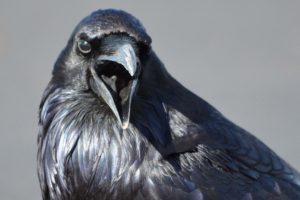
When asked to picture ravens and crows, what comes to your mind? If you think of images such as the unsettling visitor from Edgar Allen Poe’s famous poem “The Raven,” you’re not alone. Unsurprisingly, these inky avian creatures are also a staple of Halloween décor, probably thanks to humankind associating them with death, danger and ill omens. Even our terms for groups of these animals sound ominous, with a pack of crows called a “murder” and a flock of ravens referred to as an “unkindness” or a “conspiracy.” How did these black birds get such a bad reputation, and has humanity always regarded them with suspicion and fear? The answers to these questions might surprise you.
What Science Says About These Birds
Ravens and crows are both classified by science as corvids, a subfamily of birds that also includes rooks, magpies, jays and jackdaws. Scientists posit that they’re more intelligent than other birds, deriving their conclusions from observations of them using tools and developing ingenious tactics to get their needs met. For instance, a BBC Wildlife video narrated by David Attenborough shows a carrion crow dropping a nut into oncoming traffic to let vehicles crack it open, then waiting until pedestrians cross the street to collect a delicious reward. Many species of corvids live in strong community groups, display altruistic behaviors and form lifelong mating bonds. Most are omnivorous, eating anything from fruits and nuts to carrion.
Divine Messengers and Omens of Death
It’s likely that corvid diets of carrion caused humans to associate them with death. One example comes from the Irish Ulster Cycle folktales depicting the Morrígan, a Celtic goddess that the Encyclopedia Britannica reveals was sometimes called “badb,” the Irish word for crow. She’s been linked to the Morgan le Fay of Arthurian legends, and some sources suggest she may be a triple goddess. Nevertheless, the Ulster Cycle stories show her as a singular divine being shapeshifting into the form of a corvid and foretelling the death of the hero Cú Chulainn in battle.
Meanwhile, other legends show these avian beings as helpful messengers and servants to the gods. Norse mythology tells of two ravens named Huginn and Muninn serving Odin by fetching him information from all over the world. Ancient Greeks saw them as tokens of good luck, aiding Apollo by spying for him and bringing him messages. Shani, a Hindu deity associated with the planet Saturn, disruption, chaos and fate, is typically depicted riding on a raven.
Ravens and Crows as Trickster Deities
In other parts of the world, ravens and crows were imagined as trickster deities. Tales from various Indigenous peoples from the Pacific Northwest include Raven as a central hero helping others through his cunning and tomfoolery. He is described by an article on the American Museum of Natural History’s website as a “powerful figure who transforms the world” with acts such as creating land, releasing humans from a cockle shell, bestowing them with the gift of fire and stealing the sun from the Sun Chief’s lodge to light the world. Unlike Prometheus, the Greek Titan punished by Zeus for aiding humans in similar ways, Raven is never penalized for his mischief.
Their Mysterious Ways Make It Into Human Legends
Whether as creepy consumers of carrion, heralds of death and doom or clever collaborators with human and divine beings, ravens and crows have long sparked the human imagination. The mythoi of pre-Christian cultures from all over the globe have depicted them as messengers, omens or even deities. If you’re fortunate enough to witness their antics, you might take some time to appreciate their intelligence, humorous behavior and the deeper layers of meaning assigned to them by mythmaking peoples.

